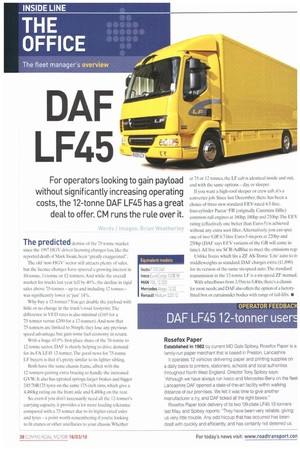For operators looking to gain payload without significantly increasing operating
Page 38

If you've noticed an error in this article please click here to report it so we can fix it.
costs, the 12-tonne DAF LF45 has a great deal to offer. CM runs the rule over it.
Words Images Brian Weatheriey
The predicted demise of the 7.5-tonne market since the 1997 I IG V driver-licensing changes has, like the reported death of Markikvain, been "greatly exaggerated".
The old 'non-HCiVsector still attracts plenty of sales, but the licence changes have spurred a growing interest in 10-tonne, 11-tonne or 12-tonners. And while the overall market for trucks last year fell by 40%, the decline in rigid sales ahove 7.5-tonnes — up to and including 12 tonnes — was significantly lower at 'just' 14%.
Why buy a 12-tonner? You get double the payload with little or no change in the truck's road footprint. The difference in V ED rates is also minimal (£165 for a 75-ton ner versus £201) for a 12-tonner). And now that 7.5-tonners are limited to 56mph, they lose any previous speed advantage, but gain some fuel economy in return.
With a huge 43.9% first-plaec share of the 7.6-tonne to 12-tonne sector. DAF is clearly helping to drive demand for its FA LF45 12-tonner. The Rood news for 7.5-tonne LF buyers is that it's pretty similar to its lighter sibling.
Both have the same chassis frame, alben with the 12-tcmners gaining extra bracing to handle the increased GVW. It also has uprated springs. larger brakes and bigger 245/70R175 tyres on the same 17.5-inch rims, which give a 4,480kg rating on the front axle and 8,4804 on the rear.
So, even if you don't necessarily need all the 12-tonner's carrying capacity. it provides a lot more loading tolerance compared with a 7.5-tormer due to its higher-rated axles and tyres — a point worth remembering if you're looking to fit cranes or other ancillaries to your chassis. Whether at 7.5 or 12 tonnes, the LF cab is identical inside and out, and with the same options — day or sleeper.
If you want a high-roof sleeper or crew cab, it's a converter job. Since last December, there has been a choice of three new standard EEV-rated 4.5-litre, four-cylinder Paccar 'FR (originally Cummins ISBe) common-rail engines at 160hp, 180hp and 210hp.T1e EEV rating (effectively one better than Euro-5) is achieved without any extra soot filter. Alternatively, you can spec one of two -GR 6.7-litre Euro-5 six-pots at 220hp and 250hp (DM' says EE,V variants of the GR will come in time). All five use SCR/AdBlue to meet the emissions regs Unlike lveco, which fits a ZF AS-Tronic 'Lite auto to ib middleweights as standard. DAF charges extra (i1.890) for its version of the same six-speed auto. The standard transmission in the 12-tonne LF is a six-speed ZF manual.
With wheelbases from 3.55m to 5.40m, there's a chassis for most needs; and DAF also offers the option of a factoryfitted box or curtainsider bodies with range of tail-lifts. II




























































































































